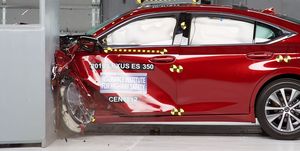- A new rulemaking proposal by the National Highway Traffic Safety Administration (NHTSA) would redefine terms to allow easier certification of autonomous vehicles.
- Driverless cargo vans, for example, may be fully exempt from occupant safety standards.
- NHTSA wants to protect children from being placed at the controls of an autonomous vehicle.
While they portend a future of zero accidents, automated vehicles won’t be exempt from U.S. crash-test standards in the near term, according to a new proposal from the National Highway Traffic Safety Administration (NHTSA). In some cases, automakers will have to prove future versions of the cars are even safer than they are now.
NHTSA plans to modify what it calls its “200 series” of rules within the Federal Motor Vehicle Safety Standards, the bible by which automakers certify that their cars crumple, deform, warn, and operate to strict baselines—and, most important, protect the people inside. The issues raised by automakers and tech offshoots like Google’s Waymo are specific language and definitions in these rules that would make certifying self-driving cars next to impossible. It’s a small but significant step in future-proofing the agency’s requirements for when automated cars comprise some 30 percent of new-car sales by 2050, according to the proposal.
“If done correctly, this should help streamline manufacturers’ certification processes, reduce certification costs, and minimize the need for future NHTSA interpretation or exemption requests,” the agency wrote.
The hot button? The words “driver,” “driver’s,” and “driving” appear about 200 times in the rulebook. In 2018, NHTSA first proposed that it would redefine “driver” to mean either a person or an automated system. Now it has reversed course.
The definition of a “driver” won’t change, but when the proposal becomes an enforceable rule, the requirements will specifically call out whether they apply to humans or an automated system. NHTSA will also add the term “manually operated driving controls” to indicate that the occupant in this seat will have access to the car’s steering and longitudinal motion. As for steering wheels, they won’t have to be wheels. Steering “control” will be the new term. But even if these controls can fold or disappear into the car’s interior while in automated mode, they have to be within the occupant’s control at all times.
Since every seat would be a passenger seat in a self-driving car, NHTSA wants to apply the front passenger’s crash-test standards to what is now the driver’s position. While the agency’s crash-test procedures use the same dummies and protocols for both front passengers, the driver’s side—with pedals and a steering wheel—will have different design requirements than the passenger’s side, which must accommodate children and smaller-sized adults. Children are in particular danger, the agency said, if the rules become too lax so that they could sit in what was the driver’s seat where manual controls are available. Such a scenario is “foreseeable and unacceptable,” to which NHTSA responded with a future mandate to require current passenger-seat sensors to detect if a child is in the seat and completely restrict the vehicle from moving.
The best news comes for companies like Amazon that want to flood our neighborhoods with driverless delivery pods. None of these vehicles will have to comply with occupant protection standards (such as heads hitting the inside parts of an interior) since they will have no seats. But NHTSA is still treading carefully, as any reduction in safety requirements on these vehicles could put everyone else in normal cars at a greater risk during a crash.
The takeaway: The rules aren’t bending that much. NHTSA says that more research is needed before truly significant changes are turned into law. That means all the concepts you’ve seen with lounge-style seating won’t be allowed on the road for a long time. NHTSA says that nontraditional seating, including seats only positioned in the center of such vehicles, have not been properly evaluated. Automated cars will not be able to shed thousands of pounds by forgoing the crash structures, airbags, seatbelts, windows, warning lights, and all the other conventional equipment that we take for granted.
It’s also not changing how states regulate public testing of automated vehicles. According to the Governors Highway Safety Association, a dozen states allow testing without a person in the vehicle. But these are limited, experimental runs. The new federal rules are merely a preview for when cars without steering wheels and pedals roll down an assembly line. And that’s not happening anytime soon.
Source: Motor - aranddriver.com





